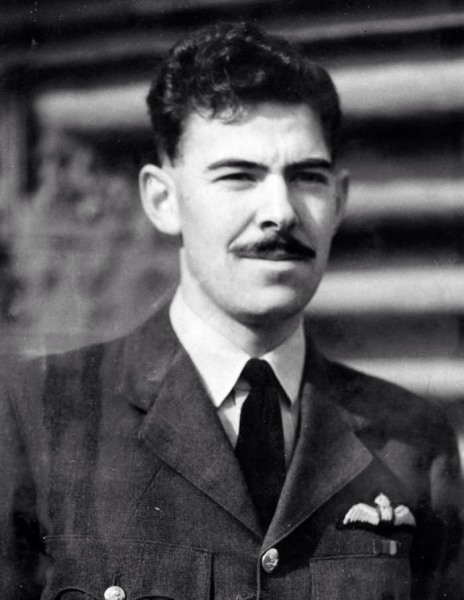Cruickshank, John Alexander
- Date of birth:
- May 20th, 1920 (Aberdeen/Scotland, Great Britain)
- Date of death:
- August 16th, 2025
- Service number:
- 657722/126700
- Nationality:
- British
Biography
Promotions:
?: Sergeant;
July 10th, 1942: Pilot Officer on probation (emergency);
January 10th, 1943: Flying Officer on probation (war subs.);
July 10th, 1944: Flight Lieutenant (war subs.).
Career:
May 1939: Royal Artillery, Territorial Army;
1941: Royal Air Force;
March 1943: No. 210 Squadron, Sullom Voe;
September 1946: discharge RAF.
Flying a Catalina, JV928, on 17th July 1944 the then Flying Officer John Cruickshank attacked and sank a surfaced U-boat.
During the attacks his aircraft was hit many times, the navigator killed and three other crew injured.
Cruickshank himself was hit in 72 places, including two serious lung wounds.
Despite his injuries he insisted on carrying on and brought his aircraft to safety at Sullom Voe in the Shetlands.
John Cruickshank - whose VC award was announced in the London Gazette on 1st September 1944 - has previously been stationed with 210 Squadron at RAF Pembroke Docks.
In recent years he attended several Flying-Boat and Squadron Reunions in Pembrokeshire and in 1995 unveiled the replica RAF Pembroke Dock Memorial Window which went on view at the town library
Source: Pembroke Dock Heritage Centre
Do you have more information about this person? Inform us!
- Period:
- Second World War (1939-1945)
- Awarded on:
- March 2024
- Period:
- Second World War (1939-1945)
- Rank:
- Flying Officer
- Unit:
- No. 210 Squadron, Royal Air Force
- Awarded on:
- September 1st, 1944
"This officer was the captain and pilot of a Catalina flying boat which was recently engaged on an anti-submarine patrol over northern waters. When a U-boat was sighted on the surface, Flying Officer Cruickshank at once turned to the attack. In the face of fierce anti-aircraft fire he manoeuvred in-to position and ran in to release his depth charges. Unfortunately they failed to drop. Flying Officer Cruickshank knew that the failure of this attack had deprived him of the advantage of surprise and that his aircraft offered a good target to the enemy's determined and now heartened gunners. Without hesitation, he climbed and turned to come in again. The Catalina was met by intense and accurate fire and was repeatedly hit. The navigator/bomlb aimer, was killed. The second pilot and two other members of the crew were injured. Flying Officer Cruickshank was struck in seventy-two places, receiving two serious wounds in the lungs and ten penetrating wounds in the lower limbs. His aircraft was badly damaged and filled with the fumes of exploding shells. But he did not falter. He pressed home his attack, and released the depth charges himself, straddling the submarine perfectly. The U-boat was sunk. He then collapsed and the second pilot took over the controls. He recovered shortly afterwards and, though bleeding profusely, insisted on resuming command and retaining it until he was satisfied that the damaged aircraft was under control, that a course had been set for base and that all the necessary signals had been sent. Only then would he consent to receive .medical aid and have his wounds attended to. He refused morphia in case it might prevent him from carrying on. During the next five and a half hours of the return flight he several times lapsed into unconsciousness owing to loss of blood.
When he came to, his first thought on each occasion was for the safety of his aircraft and crew. The damaged aircraft eventually reached base but it was clear that an immediate landing would be a hazardous task for the wounded and less experienced second, pilot. Although able to breathe only with the greatest difficulty, Flying Officer Cruickshank insisted on being carried forward and propped up in the second pilot's seat. For a full hour, in spite of his agony and ever increasing weakness, he gave orders as necessary, refusing to allow the aircraft to be brought down until the conditions of light and sea made this possible without undue risk.
With his assistance the aircraft was safely landed on the water. He then directed the taxying and beaching of the aircraft so that it could easily be salvaged. When the medical officer went on board, Flying Officer Cruickshank collapsed and he had to be given a blood transfusion before he could be removed to hospital.
By pressing home the second attack in his gravely wounded condition and continuing his exertions on the return journey with his strength failing all the time, he seriously prejudiced his chance of survival even if the aircraft safely reached its base. Throughout, he set an example of determination, fortitude and devotion to duty in keeping with the highest traditions of the Service."
- Period:
- Second World War (1939-1945)
- Period:
- Second World War (1939-1945)
- Period:
- Second World War (1939-1945)
- Period:
- Second World War (1939-1945)
- Period:
- Second World War (1939-1945)
- Period:
- Second World War (1939-1945)
Sources
- Photo 1: Wilco Vermeer collection (CC Attribution Non-Commercial No Derivatives 4.0)
- - On display in Pembroke Dock Heritage Centre.
- Second Supplement to The London Gazette of 27th November 1942, Issue 35804, dated 1st December 1942
- Third Supplement to The London Gazette of 11th May 1943, Issue 36015, dated 14th May 1943
- Fourth Supplement to The London Gazette of 29th August 1944, Issue 36682, dated 1st September 1944
- John Cruickshank VC
- https://rauxaf.org/war-hero-receives-overdue-medal/














